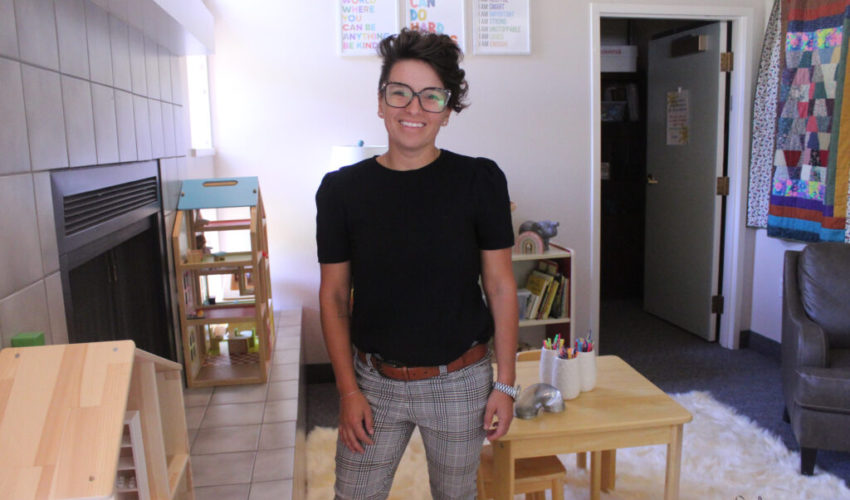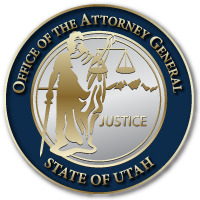Today, the Times-Independent helped the Utah Attorney General’s office shine a light on child abuse by releasing an insightful article on Grand County’s Criminal Justice Center (CJC). Featuring CJC Director Andrea Noyes, the news article focused on how Grand County, like Utah’s statewide network of 25 CJCs, offers a safe place for young victims of child abuse and sexual assault to share their stories and provide evidence against perpetrators.
View the complete Times-Independent article or read below.
August 03, 2023
By Sophia Fisher
Children’s Justice Center Director Andrea Noyes harnesses her background in law enforcement and social work to assist children who have experienced abuse.
For Andrea Noyes, the Children’s Justice Center is a place where kids can be heard.
“The kiddos need a place to have a voice and somebody that believes them,” said Noyes, hired this spring as the center’s director.
Sitting in what might aptly be called the center’s living room — decorated with a soft rug, child-sized tables and chairs, games, toys and books — it certainly feels like a place where kids are welcome. It needs to be, as it’s also a place children might find themselves on the worst day of their lives.
What is the CJC?
Founded in 1999, Grand County’s Children’s Justice Center is a space for children who have experienced abuse or witnessed crimes to share their stories in a safe, comfortable environment. Part of a statewide program administered by the Utah Attorney General’s Office, it’s one of 25 such centers across the state created to reduce the additional trauma children bore when reporting physical or sexual abuse.
“They’ve done research in the past that [shows] how law enforcement used to investigate crimes against children was actually super traumatic,” said Noyes. “They would have to go talk to a detective and then they’d have to talk to a prosecutor, then they’d have to be put on the stand. They’d have to … tell their story multiple times.”
To minimize that pain, the Children’s Justice Center provides a space for specially-trained interviewers to speak with the child. The interviews are recorded and shared with relevant parties, such as law enforcement agencies and prosecutors, so there’s no need for a child to possibly relive the trauma in subsequent tellings.
The interview room, down the hall from the main space, features subdued lighting, soft chairs and inconspicuous recording equipment. There’s also a box of crayons and colored pencils by a stack of paper. Noyes said those tools can help if a child clams up.
“We’ve found that especially for our kiddos that are male, if they’re only focused on how nervous they are to talk about things, they kind of shut down,” Noyes said. “But if they’re distracted and coloring and doing something, they’ll tell you everything that’s gone on.”
The center also includes a fully equipped medical room where specialized nurses from the Primary Children’s Hospital can examine children for signs of abuse. Noyes said the space, and the out-of-town care, is particularly helpful for older survivors.
“Not all of our kiddos are eight,” she said. “We have 16-year-olds that come through here … they don’t necessarily want to go to the Moab hospital and see six of the nurses that they know and then go to City Market and see them.”
While interviews and exams are the core of the Children’s Justice Center, Noyes emphasized that the program — which is fully independent of law enforcement and the Utah Division of Child and Family Services — aims to remain a support system for the entire family throughout the investigation and possible prosecution of abuse.
That process can last years. In the meantime, the center screens children for signs of trauma or suicidality, connects the family with community services, and continues to advocate for the child.
“It’s nothing but support onto that family so they don’t have to go through and navigate this alone,” Noyes said.
Shining a light
While no community is immune from child abuse, Noyes told the Grand County Commission that Utah has, by some measurements, the third-highest rate of child sexual abuse in the nation.
That’s based on a 2019 survey by the Centers for Disease Control and Prevention that found 14.3% of Utah high school students had experienced sexual violence in the last year — a higher percentage than any state except Idaho and California.
“This is something that I want to make my mission to try to help lower,” Noyes told the commission June 20.
In a later interview, Noyes said in the past few months she’s noted one particular kind of abuse taking hold: older men who solicit girls on the internet before meeting up in-person.
“Because our pre-teens, like sixth, seventh, eighth grade have phones, have social media, these 24-, 25-year-old males see them as a vulnerable group,” Noyes said, “and they have access to them and then crimes are being committed.”
She praised the Grand County Sheriff’s Office’s work with the Internet Crimes Against Children Task Force and urged parents to pay attention to their teens’ phone use. (See related sidebar.)
More broadly, Noyes said she’s hoping to bolster conversation around a taboo topic. She said when she tells someone about her job, eight out of 10 times the person will start talking about an abuse.
“I think people want to be able to talk about it,” Noyes said. “But it is taboo so people don’t know what settings they can talk about it in.”
Noyes exhorted residents to report any suspected child abuse to local law enforcement. She said even if the abuser him- or herself is young, bringing the situation to light can stop a protracted line of abuses.
“If you know a five-year-old that’s abusing a three-year-old, the likeliness is that they’re getting abused,” Noyes said. “So it’s important to report it because we might be able to save a lot of kiddos from abuse who are being abused by much older people.”
It’s also crucial to take seriously children who vocalize abuse. Noyes said one of the highest indicators of an abused child’s later success in life is having an adult who believed them.
“If your kiddo comes to you with abuse, even if you don’t believe them right away — by all appearance if you can show up for them, if you can listen to them, and your kiddo believes that you believe them, the success rates are through the roof,” Noyes said.
Moving forward
Right now, Noyes isn’t restricted to Grand County; she also serves San Juan County from a satellite office in Blanding.
On July 18, however, the San Juan County Commission voted to sign a memorandum of understanding that would establish a new Children’s Justice Center in the county. San Juan County Administrator Mack McDonald said the county received varying levels of attention from the Grand County center and that he thinks child abuse is being underreported.
“If you look at our cases dwindling here, I think it’s actually the opposite,” he said.
Grand County’s contract with San Juan ends Oct. 1, the target date for the county to open its own center.
Noyes said the splitting-off could provide each county with more resources to help some of their most vulnerable residents: children.
“If an adult’s a victim of a crime, an adult can pick up the phone, they can make a phone call and then can kind of self-serve through the whole process,” Noyes said, sitting in the center’s light-filled space. “Kiddos can’t do that — they need an advocate.”

